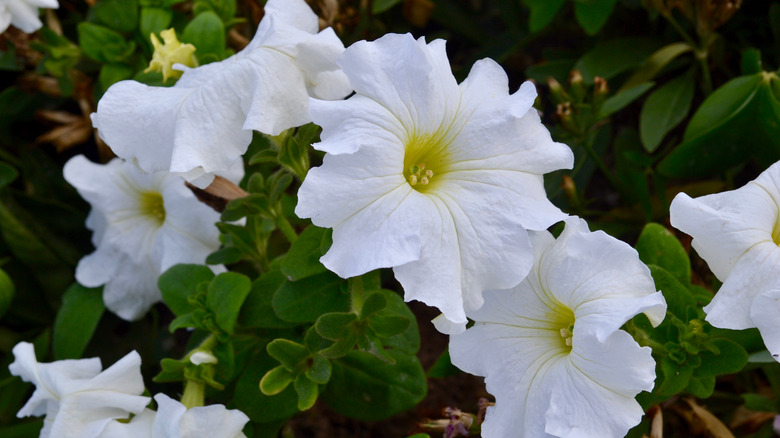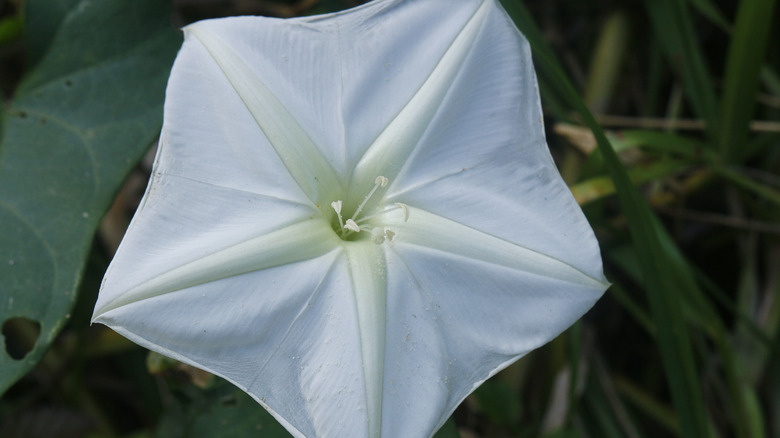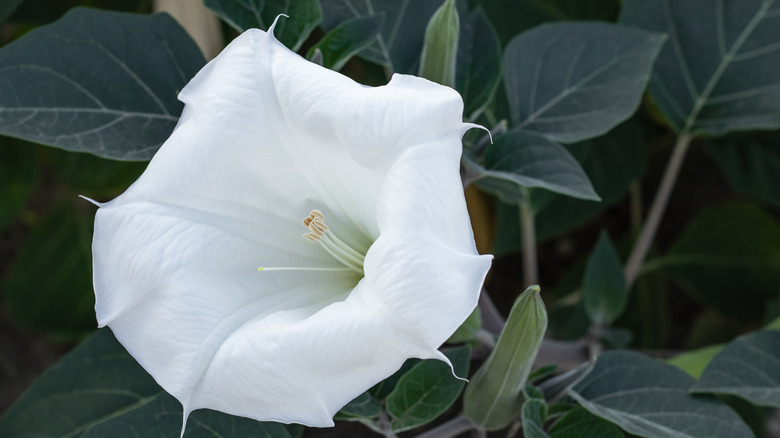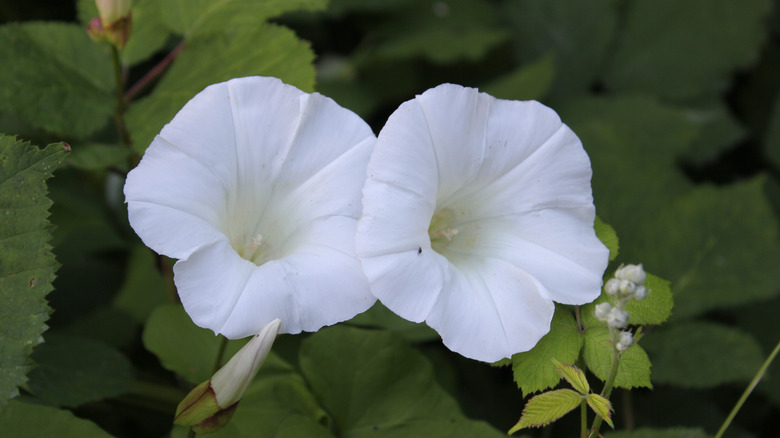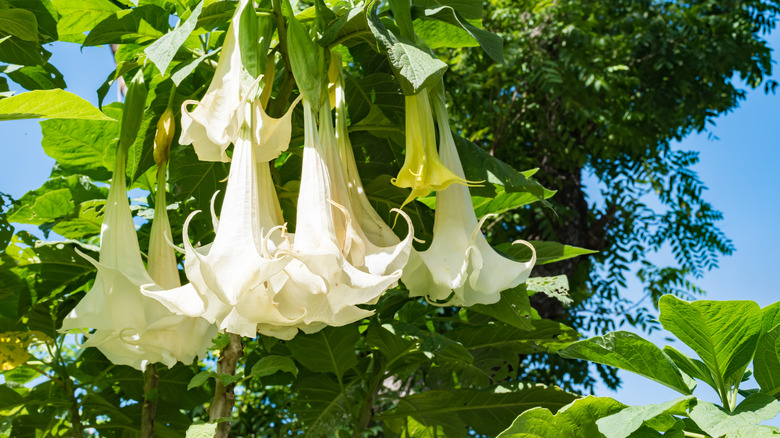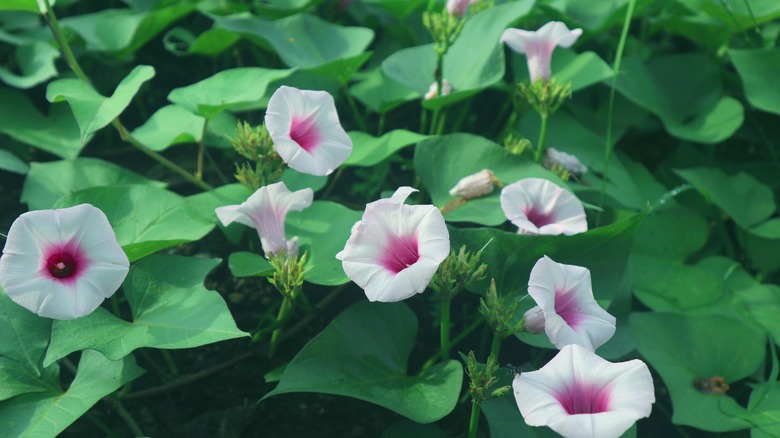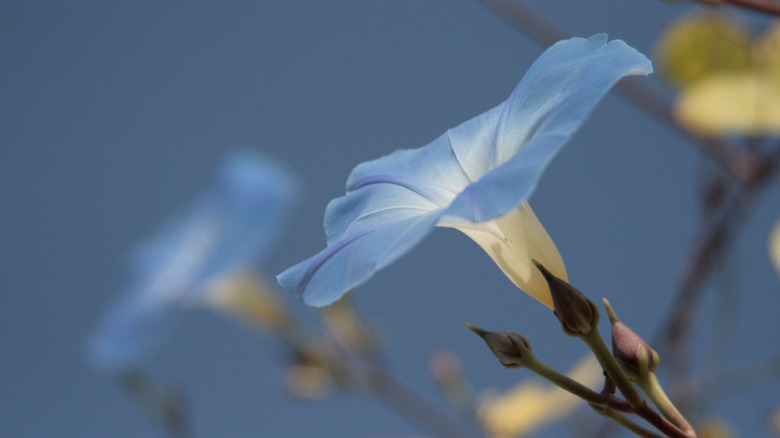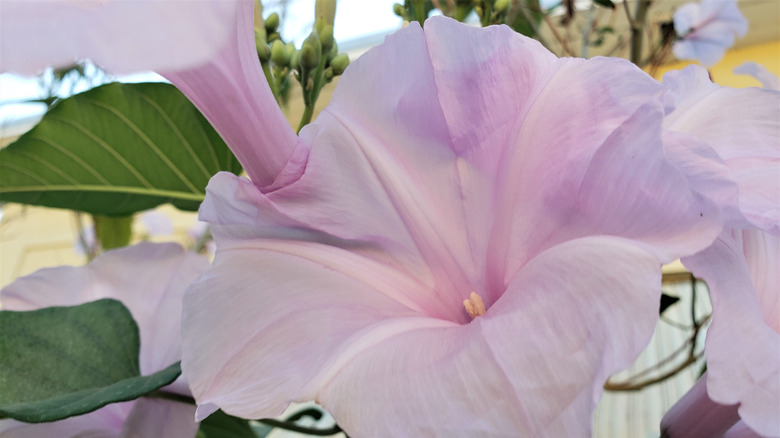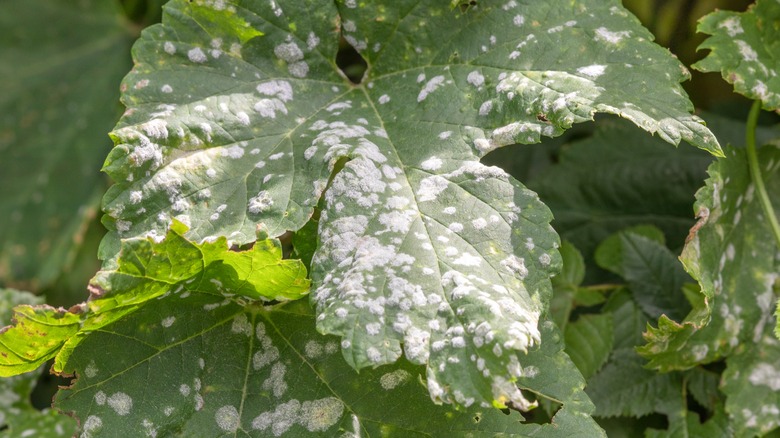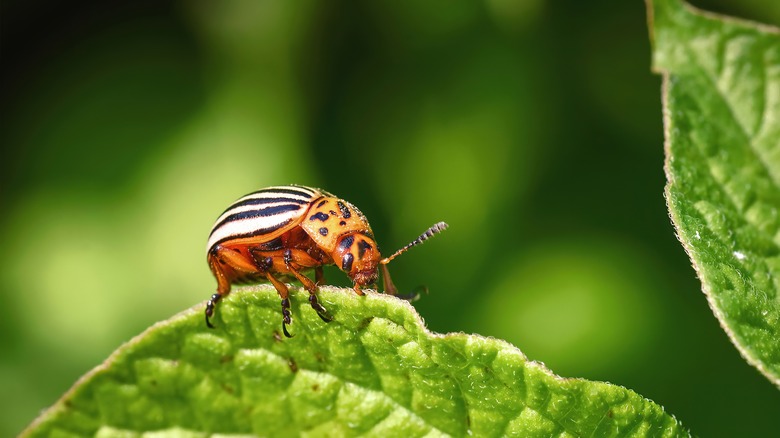Moonflowers: Everything You Should Know Before Planting
If you're into all things celestial and ethereal, then it's likely that you like the sound of moonflower plants. Gardening Know How explains that this white flowering plant is also known as Ipomoea alba, and while it's mostly associated with tropical climates, gardening enthusiasts in colder climates can grow them too.
The Spruce explains that moonflowers are a perennial vine that releases a super sweet fragrance when in bloom. These dusky white flowers get their name as they open at night or on very overcast, cloudy days. During the day they'll close tightly into oval-shaped buds and their leaves are heart-shaped. When open they're around 3 to 6 inches wide and six inches long. Moonflowers are also known as tropical white morning glory, moon vine, evening glory, and the moon creeper, and are native to North America, Central America, and South America.
When grown in ideal conditions with the right temperature and humidity, Better Homes & Gardens writes that the vines on moonflowers can grow up to 20 feet long. Additionally, as a cousin of the morning glory, there's one key fact to remember when you're growing moonflowers: They're highly toxic to both pets and humans. That isn't to say you can't keep them though. To that end, before you take the deep dive into investing time, energy, and hope, here's everything you should know before planting moonflowers.
How to use moonflowers in garden
Rather than thinking about outward space, when you're growing moonflowers all you need to consider is where they can reach. As vines, they're natural climbers and will need to be able to hold onto a structure. Gardening Know How writes that if you instill a trellis or archway, moonflower vines will cling and weave their way around it.
This may not provide much of a spectacle in the day. However, at night the flowers will open to release their pungent, sweet scent and it'll provide the perfect garden decoration. Rather than planting them when the summer is its hottest, you should sow moonflower seeds when it's about 60 to 70 degrees Fahrenheit. You can do this in a bed or container.
Den Garden explains that sowing your moonflower seeds shouldn't be too much of a concern. It's keeping the vines at bay once they've started to grow that can be an issue. The site writes that once the flowers bloom and are pollinated by moths, the plant can spread its seed and start to take over your garden.
How to grow moonflowers
Once you've acquired the seeds for moonflowers, you need to do a little bit of preparation before you plant them. Firstly, Den Garden explains that you must wash your seeds; you should soak your seeds overnight as the seed shell can be really tough and the water can help to prepare them for germination.
The Spruce explains that once you've prepared your seeds you can place them in your soil and bury them about ¼ inch deep. You don't need to use fertilizers with moonflowers; Gardening Know How even warns that if you use too much nitrogen fertilizer you may limit how your moonflowers bloom. You can place a seed-starter mix in the soil to help encourage initial growth.
Rather than placing the seeds in restricting planters or pots, it's ideal to put moonflowers straight in biodegradable peat pots which their roots can eventually outgrow. Put them in a spot with lots of warmth and sunlight. Try not to touch the roots of your moonflowers once you've planted them, as you risk damaging or killing the plant by disturbing the roots. Better Homes & Gardens writes that if you're worried that your moonflowers are a little bit too established and the vines are taking over your garden, then you can pluck or clip off the seed pods before they open to prevent them from spreading. If you keep them in a warm and dry place you can replant them.
How to care for moonflowers
Aside from their hypnotic smell and ethereal look when they bloom, one of the best things about moonflowers is they are relatively low maintenance. Plant Care Today explains that gardeners simply need to remember to keep the soil that they're planted in well-drained, ensure they are getting plenty of sun, and water throughout the week to prevent dehydration.
Care for your flowers may slightly differ depending on one where you live. This is because moonflowers are natively tropical plants and will only thrive in optimal conditions. If you live in the southern hemisphere, then you should ensure that the roots are mulched at all times. If you live in the northern hemisphere, then you may consider carefully digging up and transferring your moonflowers inside during the colder months. Additionally, Gardening Know How writes that fertilizers rich in phosphorus can encourage your flowers to grow large. However, fertilizers with a high nitrogen content may leave you with vines luscious in heart-shaped leaves with few flowers.
Aside from watering your moonflowers and ensuring they're getting maximum sunshine, go with your gut. It's a pretty resilient plant and can fight off most common pests and diseases. However, if you do notice that your plant is damaged then you can treat it with pesticide.
Varieties of moonflowers
Moonflowers are named after their distinctive look and the unique fact that they bloom at night or in gloomier conditions. You may be most used to seeing the circular, white variety of moonflower. However, it's quite a diverse plant. Gardening Channel explains that the moonflower referred to throughout this article is Ipomoea alba. When the flowers bloom they are pearly white. There's also Datura innoxia which is much smaller, growing to about 4 inches tall. The vine is covered in small, grey hairs.
Garden Guides writes that if your flowers are more yellow in color and give off the scent of lemons then, you may have planted evening primrose, and if they're longer in shape and measure at 6 inches then you could have angel's trumpets. Flowering Tobacco and Four O'Clock are also varieties of evening and night-blooming flowers. However, they differ in look from Ipomoea alba quite dramatically. Flowering Tobacco can be deep crimson in color while Four O'Clock can be a more delicate red and yellow.
Can you propagate moonflowers?
According to Team Flower, propagating plants is a great way to grow flowers, save money, and get the exact flowerings that you want in your garden. Moonflowers are annuals in most growing regions and self-seed as long as they have established a patch (via TheWeekendGardener). You can also collect the seed pods once the plant is completely dry, usually in the fall. Once the seed pods are dry, you can crack them open and plant them as you wish.
However, like traditional flowering plants, you can also propagate moonflowers by cutting them. To increase your chance of successful propagation, avoid cutting blooming flowers. Additionally, cuttings should be about 4 inches long with the excess leaves stripped down. This prevents the stem from giving energy to the leaves and encourages the roots to grow.
After you've prepared the cutting, it should be placed into a shallow pot that's pressed with soil. When your cutting is potted, lightly mist it to encourage humidity. To encourage root growth, placing a plastic bag over the plant is recommended to increase humidity.
Are moonflowers toxic?
Moonflowers may be pretty easy to grow and will spread far and wide across your garden if allowed. However, this comes with a catch: If consumed at all, then the moonflower is seriously poisonous to humans and animals alike. H2ouse explains that from the roots to the leaves, flowers, seeds, and sap, the moonflower can be lethal. Fortunately, many animals will avoid eating moonflowers due to the scent that they release — think of it as being a warning scent. However, all creatures great and small will be affected by moonflower if they consume it so it's better not to grow it around pets.
A key sign that your animal has consumed parts of your moonflower plant is if they're lethargic or unresponsive. In the same way, Leaf TV writes that moonflower plants can impact human nervous systems. The CDC also reports that after consuming moonflowers you may experience adverse mental health effects, like hallucinations, confusions, sickness, convulsions, and may even enter a coma.
How to re-pot moonflowers
Like many other vine plants, the roots of moonflowers have to be strong to anchor them into the ground. However, if they're broken, interfered with, or separated then your moonflower plant may die. If you need to transplant them then you should do so with great care and ensure that you've cut around all of the roots, leaving ample soil coverage.
SF Gate writes that the best way to prevent any damage to the roots of the moonflower is to plant them in peat pots which they can outgrow, and if you are going to move them then you should do so before they've grown and reached their full height potential. Additionally, Den Garden writes that since maintaining the integrity of the moonflower plant's roots is so important, it's hard to repot them or move them after you've planted the seeds. However, you can cut back the seed pods, collect them, and replant them in other areas in your garden
Diseases to look out for
According to C-I-L Lawn and Garden, diseases in flowering plants are rare but can happen when improperly cared for or if diseases are spread from neighboring flowers. Flowering plants, like the moonflower, are susceptible to sooty mold, when leaves and stems are speckled with a soot-looking black film. Additionally, plants can also get root rot, which is a soil-borne fungus that attacks a plant's roots and causes them to weaken or stunt its growth. Flowering plants are also impacted by white rust, which is characterized by rust-colored growth that's sometimes powdery (via Gardening Bank). The spores cause damage to the leaves, which diminishes the plant's health and affects its flower production. If white rust goes unchecked, it can spread to nearby plants.
Flowering plants are also susceptible to damping off, which is when a seedling looks healthy but suddenly dies (via Planet Natural). The sudden death can result from fungi or poor growing conditions and drainage.
Common pests and how to get rid of them
Like all plants, the moonflower isn't immune to attacks by annoying pests. According to PlantSnap, plants are commonly attacked by spider mites, which are tiny pests that look like black, brown, red, or yellow spiders. Spider mites suck out the chlorophyll in plants which causes leaves to develop white dots (via Terminix). To get rid of spider mites, you must remove the leaves that are infected from your plant and spray the rest down with a 70% rubbing alcohol and water mixture.
Plants can also be attached by aphids, which are fast reproducing, sap-sucking insects (via YouTube). Aphids typically resolve themselves naturally, but they sometimes need to be sprayed. One of the easiest ways to remove aphids from your garden is to spray the softest part of your plant with a hose. You can also use insecticidal soap on the plant to remove aphids and other pests.
Your moonflowers can also be affected by Japanese beetles. These beetles can destroy plants at the root and leaves depending on their lifecycle phasen (via The University of Maine). To help control the Japanese beetle population in your garden, you can shake the beetles into a bucket filled with a mixture of dish soap and water. Additionally, you can vacuum beetles with a small vacuum.
Your garden can also be attacked by hornworms, which are the larva of hawk moths (via MIGardener). Hornworms can eat through entire gardens in a few days, devouring the leaves and other parts of the plant. The best way to get rid of hornworms is to pick them off the leaves or use a BT spray. Plants can also be affected by leaf miners that create a zig-zag-looking pattern on leaves (via Garden Tips). One of the best solutions to remove leaf miners is to use neem oil and spray at night.
